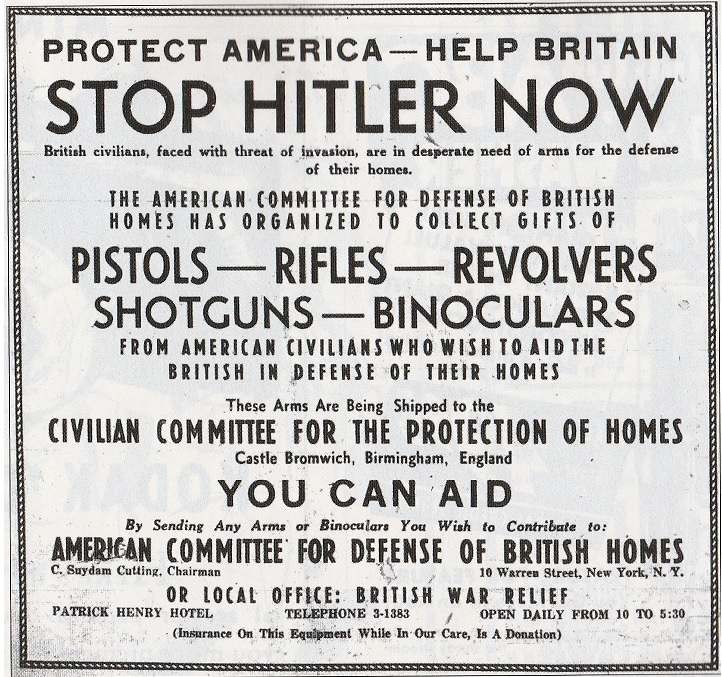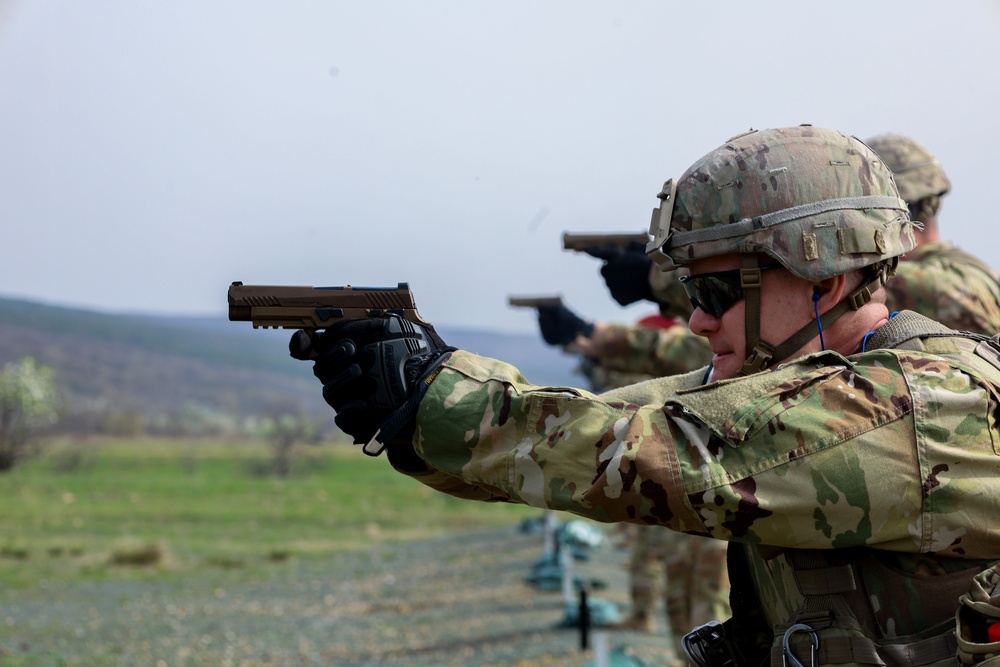The American Committee for the Defense of British Homes
- By Travis Pike
Share This Article

As Nazi Germany attacked Europe, America initially took a position of neutrality. However, while the government remained neutral, there was support for the British, particularly among the American civilians. This led to the creation of the American Committee for the Defense of British Homes.
The American Committee for the Defense of British Homes was a mouthful, so they kept it brief and called it the ACDBH, which isn’t that much shorter. The group’s main purpose was to send firearms to the U.K. to help British civilians protect their homes. The British were short on weapons, especially after the Dunkirk evacuation, and well, America is never short on weapons (I love this country).
The group was quite influential, but ultimately, beyond its advocacy, it had very little effect on the war effort or even the protection of British homes.
The early advocacy of the American Committee for the Defense of British Homes
Americans were aghast at the Nazi war machine. Many had ties to Britain which was seen as an ally and friend, especially after World War I.
The earliest advocacy came from the Committee to Defend America by Aiding Allies, or CDAAA, which set up the American Committee for the Defense of British Homes to provide arms as it didn’t want its direct lobbying power to be at risk.
The American Committee for the Defense of British Homes had some real powerhouses on its board including Douglas Wesson of S&W, Albert Foster of Colt, Karl Frederick of the NRA, and radio broadcasters, authors, and others.
Across the pond, many British were willing to fight but couldn’t qualify for the regular army due to age or disability. So, the British military formed the Local Defence Volunteers, which became the Home Guard.
However, it was overwhelmed with volunteers and called for civilians to turn over arms, which resulted in some 20,000 firearms donated to the cause. Yet, as these were mostly sporting arms, a real need for more capable weapons for the Home Guard was created.
Related: Exploring the CMG, Colt’s forgotten machine gun
The British response

The British response to the idea of receiving firearms from the United States was mixed. Some were very much for it. Lord Beaverbrook, the minister for aircraft production, was a massive supporter of the cause and agreed to take arms to guard the Ministry of Aircraft Production facilities.
Yet, there were some concerns by the British Foreign Office that the weapon donations would violate the Neutrality Act. Another concern was the propaganda that the Germans could use against the British. Further, there was a concern that Beaverbrook was looking to arm a personal army, so he was reminded that the Home Guard was under the War Office.
There was some back and forth, but ultimately, the scheme was allowed to play out. The British military and government weren’t that interested in the equipment the American Committee for the Defense of British Homes would provide. Instead, they wanted to raise American support politically and hopefully obtain more benefits under the Lend-Lease Act.
The American Committee for the Defense of British Homes received a permit from the State Department to export weapons to Britain. However, they accidentally listed the receiver as the Civilian Committee for the Protection of Homes in Britain, which didn’t exist, so the Citizen’s Defense Committee had to change its name to the Civilian Committee for the Protection of Homes in Britain.
Getting guns to Britain

The American Committee for the Defense of British Homes set up shop in all states with 364 committees. They received weapons donated by civilians and also appealed to police, prisons, and the FBI. The police organizations donated confiscated weapons used in crimes and even guns that were out of service. Of note, a rifle from Theodore Roosevelt and one from champion marksman Major John W. Hession were also donated.
The Home Guard was portrayed as a civilian body to comply with export restrictions and the American Committee for the Defense of British Homes claimed the weapons were going to British civilians interested in guarding their homes – it wasn’t mentioned that, in reality, they would be used to defend aircraft facilities.
The British government distanced itself from the donations and did not encourage or publicize them. However, Lord Beaverbrook, after resigning his post thanked the American Committee for the Defense of British Homes and publicly supported the donations.
Over 25,000 firearms were donated to the effort. At least half the donations weren’t guns but money to buy and donate guns. Helmets, compasses, and stopwatches were considered more valuable than the weapons donated.
The weapons and equipment were shipped from New York. Rifles and submachine guns were issued as needed. Equipment like binoculars and stopwatches was also issued for various tasks, like watching for naval mines and timing German aircraft.
The program’s end
After the Lend-Lease Act came into effect, the British were well-armed, and donations from the American Committee for the Defense of British Homes slowed. The British even intercepted and halted a large donation of revolvers because it could potentially interrupt their own supply chain. While donations continued during the war, the facade of donating weapons to British civilians was long over and donations went directly to the War Office.
Once America entered the war, the donations essentially ended.
The program was not effective in arming soldiers. The biggest success was improving British-American relations and obtaining more political support from the American people.
We can see a modern parallel between the United States and Ukraine. Donated items, including armor, optics, and guns, have arrived in Ukraine. This time, gun companies like Adams Arms, KelTec, and Kimber, and major ammo companies donate guns and ammo to Ukraine’s war effort. The protection of democracy and the use of arms to protect one’s home is deeply ingrained in American culture. It was true then, and it’s true now.
Read more from Sandboxx News
- Combat swimmer operations and their importance in a near-peer conflict
- The big problem with the Air Force’s ‘Light Fighter’ concept
- Video: Let’s talk about Ukrainian F-16s seeing action for the first time
- Runaway costs and design delays: Are Coast Guard’s new icebreakers worth it?
- The implications of Ukraine’s invasion of Russia
Related Posts
Sandboxx News Merch
-

‘AirPower’ Classic Hoodie
$46.00 – $48.00 Select options This product has multiple variants. The options may be chosen on the product page -

‘Sandboxx News’ Trucker Cap
$27.00 Select options This product has multiple variants. The options may be chosen on the product page -

F-35 ‘Lightning’ Framed Poster
$45.00 – $111.00 Select options This product has multiple variants. The options may be chosen on the product page

Travis Pike
Travis Pike is a former Marine Machine gunner who served with 2nd Bn 2nd Marines for 5 years. He deployed in 2009 to Afghanistan and again in 2011 with the 22nd MEU(SOC) during a record-setting 11 months at sea. He’s trained with the Romanian Army, the Spanish Marines, the Emirate Marines, and the Afghan National Army. He serves as an NRA certified pistol instructor and teaches concealed carry classes.
Related to: Military History

The HK MK23 built for SOCOM was the first and last offensive handgun

The slick custom shotgun carried by a Navy SEAL point man in Vietnam

Are the Army’s old Beretta M9 and new SIG M17 pistols as similar as people think?

The Switchblade, loitering munitions, and the new terrifying face of warfare
Sandboxx News
-

‘Sandboxx News’ Trucker Cap
$27.00 Select options This product has multiple variants. The options may be chosen on the product page -

‘AirPower’ Classic Hoodie
$46.00 – $48.00 Select options This product has multiple variants. The options may be chosen on the product page -

‘AirPower’ Golf Rope Hat
$31.00 Select options This product has multiple variants. The options may be chosen on the product page -

‘Sandboxx News’ Dad Hat
$27.00 Select options This product has multiple variants. The options may be chosen on the product page
